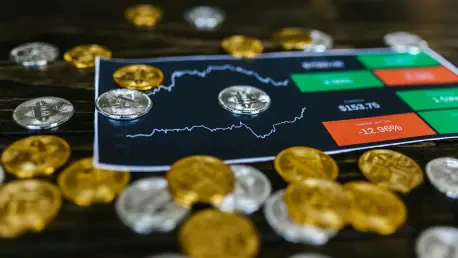The cryptocurrency market is experiencing a seismic shift as XRP futures trading on the Chicago Mercantile Exchange (CME) has skyrocketed to an astounding $1.6 billion in trading volume during July, marking a significant turning point for crypto derivatives. This unprecedented milestone, fueled by over 9,100 contracts exchanged in a single day, underscores a surge in institutional confidence. Far beyond a mere statistic, this achievement signifies that digital assets are no longer on the fringes of finance but are steadily embedding themselves into regulated markets. It reflects a growing acceptance of cryptocurrencies as credible investment options among major financial players. This remarkable development hints at a future where the lines between traditional and digital finance continue to blur, setting the stage for broader discussions on market dynamics, regulatory landscapes, and the evolving role of XRP in the global economy. The implications of this surge are vast, promising both opportunities and challenges for the entire crypto ecosystem as it navigates uncharted territory.
Surging Institutional Interest in Crypto Derivatives
The dramatic rise in XRP futures trading volume to $1.6 billion on the CME highlights a profound trend of institutional adoption sweeping through the cryptocurrency sector. Regulated derivatives have emerged as a trusted avenue for large investors who prioritize security and transparency when dipping into the volatile world of digital assets. This shift is not merely about numbers but about a fundamental change in perception, where cryptocurrencies are increasingly viewed as viable components of diversified portfolios. Industry voices, such as Tim McCourt, Global Head of Financial & Digital Asset Products at CME Group, have pointed to XRP’s critical role in shaping the digital marketplace. This growing interest from institutional players signals that the infrastructure supporting crypto investments is maturing, creating a more stable environment for market participation and laying the groundwork for even greater integration into mainstream financial systems over time.
This surge in institutional engagement also speaks to the evolving sophistication of the crypto market itself. Once seen as a speculative playground for retail investors, the space is now attracting serious capital from hedge funds, asset managers, and other financial giants through platforms like the CME. The trading of over 9,100 XRP futures contracts in a single day is a clear indicator of this shift, demonstrating a level of liquidity and interest that was previously unimaginable. Such activity not only boosts confidence among existing participants but also draws in new players who may have been hesitant due to perceived risks. The regulated nature of these futures contracts provides a safety net, mitigating some of the concerns around volatility and fraud that have historically plagued the sector. As this trend continues, it could catalyze further innovations in financial products tailored to institutional needs, reshaping how cryptocurrencies are perceived and utilized in broader economic contexts.
Potential Impact of XRP ETFs on Market Dynamics
Speculation around the introduction of an XRP exchange-traded fund (ETF) is adding fuel to the already intense excitement surrounding the cryptocurrency’s futures success. Should such a product gain regulatory approval, it could serve as a transformative force, significantly easing access for institutional investors and potentially redefining XRP’s standing in global financial markets. ETFs have historically proven to be powerful tools for driving market interest and capital inflows, as seen with other asset classes like gold and equities. The prospect of an XRP ETF is viewed by many as a logical next step following the futures boom, offering a more accessible and familiar investment vehicle for those wary of direct crypto exposure. This development could unlock new waves of investment, further cementing digital assets as staples in diversified financial strategies.
Beyond accessibility, the potential approval of an XRP ETF carries broader implications for market stability and growth. Such a product would likely attract a wider pool of investors, including those who are more risk-averse but intrigued by the promise of cryptocurrencies. This influx could help smooth out some of the notorious price swings associated with digital assets, fostering a more predictable market environment. Additionally, the regulatory oversight that accompanies ETFs might enhance credibility, addressing lingering doubts about the legitimacy of crypto investments. However, the road to approval is fraught with hurdles, as regulators remain cautious about the risks tied to volatility and market manipulation. The outcome of this process will likely set a precedent for other cryptocurrencies seeking similar financial products, making it a closely watched saga in the industry. The possibility of an ETF underscores the transformative potential of XRP’s current momentum, hinting at a future where digital currencies play a central role in investment portfolios.
Regulatory Strategies Fueling Trust and Legitimacy
Ripple, the company behind XRP, is taking decisive steps to align with regulatory frameworks, a move that is pivotal to the cryptocurrency’s growing acceptance among institutional investors. By actively pursuing banking licenses in key regions like the U.S. and EU, Ripple is striving to establish a foundation of trust and transparency that resonates with traditional financial entities. This strategic focus on compliance is more than a legal necessity—it’s a competitive edge in an industry often criticized for its lack of oversight. By positioning itself as a compliant player, Ripple is not only enhancing XRP’s appeal but also setting an example for how digital asset companies can bridge the gap between innovative technology and established financial systems. This approach is crucial for fostering long-term confidence among investors who prioritize regulatory clarity.
The emphasis on regulatory alignment also reflects a broader industry trend where compliance is becoming synonymous with credibility. As cryptocurrencies move closer to mainstream adoption, the ability to navigate complex regulatory landscapes is proving to be a defining factor for success. Ripple’s efforts to secure banking licenses demonstrate a commitment to building a robust ecosystem that can withstand the scrutiny of financial authorities. This is particularly significant for institutional investors who require assurance that their investments align with legal standards. Moreover, regulated futures trading on platforms like the CME complements these efforts by offering a secure environment for engagement with XRP. The synergy between Ripple’s compliance initiatives and the availability of regulated derivatives is creating a more inviting landscape for large-scale investment, potentially accelerating the integration of digital assets into conventional finance over the coming years.
Navigating Challenges in a Maturing Market
Despite the wave of optimism surrounding XRP’s futures success, significant challenges persist, particularly for smaller crypto ventures and international entities operating in this rapidly evolving space. A major concern is the heavy reliance on centralized exchanges for liquidity and crypto-fiat conversions, which often exposes these players to heightened regulatory scrutiny and operational risks. Unlike institutional giants with vast resources, smaller firms may struggle to meet the stringent demands imposed by regulators, potentially stifling their ability to innovate or compete. This disparity highlights a critical tension in the market: while the rise of XRP futures signals progress, it also risks widening the gap between well-funded institutions and emerging players. Addressing this imbalance is essential to maintaining a diverse and dynamic crypto ecosystem.
Another layer of complexity arises from the need for adaptive frameworks that can support the varied needs of all market participants. As institutional interest grows, there’s a pressing demand for policies that balance the requirements of large investors with the innovative spirit of smaller entities. Without such frameworks, the benefits of milestones like the $1.6 billion XRP futures volume could remain concentrated among a select few, limiting the broader impact on the industry. Additionally, international crypto firms face unique hurdles, including navigating differing regulatory standards across jurisdictions. The path forward will require collaborative efforts between regulators, industry leaders, and technology innovators to create an inclusive environment where growth and compliance coexist. Only through such measures can the transformative potential of digital assets be fully realized, ensuring that the momentum seen with XRP futures translates into sustainable progress for the entire market.
Reflecting on a Milestone and Future Pathways
Looking back, the surge in XRP futures trading to $1.6 billion on the CME during July stood as a defining moment for cryptocurrency derivatives, encapsulating a newfound trust among institutional investors. This achievement, paired with Ripple’s dedicated push for regulatory alignment, painted a picture of a maturing market poised for deeper integration into traditional finance. Challenges like liquidity constraints and regulatory pressures persisted, especially for smaller players, yet the overall trajectory pointed toward optimism. Moving forward, stakeholders must prioritize the development of inclusive frameworks that support both institutional giants and emerging ventures. Exploring innovative solutions to liquidity issues and advocating for balanced regulations will be key steps in sustaining this momentum. As the industry evolves, the focus should remain on harnessing the transformative power of digital assets to create a financial landscape that benefits a wide array of participants.









